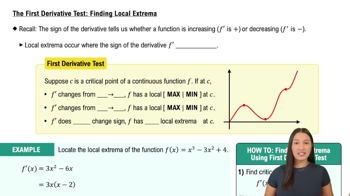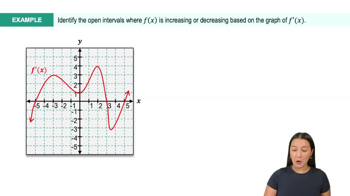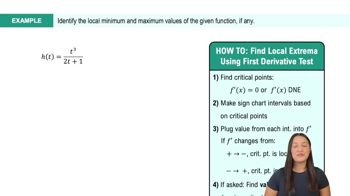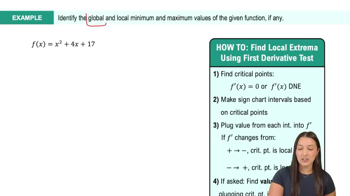Table of contents
- 0. Functions7h 52m
- Introduction to Functions16m
- Piecewise Functions10m
- Properties of Functions9m
- Common Functions1h 8m
- Transformations5m
- Combining Functions27m
- Exponent rules32m
- Exponential Functions28m
- Logarithmic Functions24m
- Properties of Logarithms34m
- Exponential & Logarithmic Equations35m
- Introduction to Trigonometric Functions38m
- Graphs of Trigonometric Functions44m
- Trigonometric Identities47m
- Inverse Trigonometric Functions48m
- 1. Limits and Continuity2h 2m
- 2. Intro to Derivatives1h 33m
- 3. Techniques of Differentiation3h 18m
- 4. Applications of Derivatives2h 38m
- 5. Graphical Applications of Derivatives6h 2m
- 6. Derivatives of Inverse, Exponential, & Logarithmic Functions2h 37m
- 7. Antiderivatives & Indefinite Integrals1h 26m
- 8. Definite Integrals4h 44m
- 9. Graphical Applications of Integrals2h 27m
- 10. Physics Applications of Integrals 2h 22m
5. Graphical Applications of Derivatives
The First Derivative Test
Problem 19
Textbook Question
Use ƒ' and ƒ" to complete parts (a) and (b).
a. Find the intervals on which f is increasing and the intervals on which it is decreasing.
b. Find the intervals on which f is concave up and the intervals on which it is concave down.
ƒ(x) = x⁹/9 + 3x⁵ - 16x
 Verified step by step guidance
Verified step by step guidance1
First, find the first derivative ƒ'(x) of the function ƒ(x) = \( \frac{x^9}{9} + 3x^5 - 16x \). Use the power rule for differentiation: \( \frac{d}{dx} x^n = nx^{n-1} \).
Calculate ƒ'(x): \( \frac{d}{dx} \left( \frac{x^9}{9} \right) = x^8 \), \( \frac{d}{dx} (3x^5) = 15x^4 \), and \( \frac{d}{dx} (-16x) = -16 \). Therefore, ƒ'(x) = x^8 + 15x^4 - 16.
To find the intervals where ƒ is increasing or decreasing, solve ƒ'(x) = 0 to find critical points. Analyze the sign of ƒ'(x) in each interval determined by these critical points.
Next, find the second derivative ƒ''(x) to determine concavity. Differentiate ƒ'(x): \( \frac{d}{dx} (x^8) = 8x^7 \), \( \frac{d}{dx} (15x^4) = 60x^3 \), and \( \frac{d}{dx} (-16) = 0 \). Thus, ƒ''(x) = 8x^7 + 60x^3.
To find intervals of concavity, solve ƒ''(x) = 0 to find inflection points. Analyze the sign of ƒ''(x) in each interval determined by these inflection points to determine where the function is concave up or concave down.
 Verified video answer for a similar problem:
Verified video answer for a similar problem:This video solution was recommended by our tutors as helpful for the problem above
Video duration:
10mPlay a video:
Was this helpful?
Key Concepts
Here are the essential concepts you must grasp in order to answer the question correctly.
First Derivative Test
The First Derivative Test involves analyzing the first derivative of a function, ƒ'(x), to determine where the function is increasing or decreasing. If ƒ'(x) > 0 on an interval, the function is increasing; if ƒ'(x) < 0, it is decreasing. Critical points, where ƒ'(x) = 0 or is undefined, are key to identifying these intervals.
Recommended video:

The First Derivative Test: Finding Local Extrema
Second Derivative Test
The Second Derivative Test uses the second derivative, ƒ''(x), to assess the concavity of a function. If ƒ''(x) > 0, the function is concave up, indicating that the slope of the tangent line is increasing. Conversely, if ƒ''(x) < 0, the function is concave down, suggesting that the slope is decreasing. Points where ƒ''(x) = 0 may indicate inflection points.
Recommended video:

The Second Derivative Test: Finding Local Extrema
Critical Points
Critical points are values of x where the first derivative ƒ'(x) is zero or undefined. These points are essential for determining intervals of increase and decrease, as well as for analyzing concavity. By evaluating the behavior of the function around these points, one can classify them as local maxima, minima, or points of inflection.
Recommended video:

Critical Points

 7:32m
7:32mWatch next
Master Determining Where a Function is Increasing & Decreasing with a bite sized video explanation from Callie
Start learningRelated Videos
Related Practice






